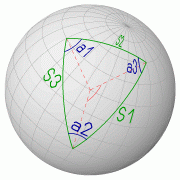Notes on Spherical Trigonometry
These notes are dealing with some principles of spherical trigonometry,
which are relevant for practical navigation on a globe. Spherical trigonometry
differs from plane trigonometry in the fact that the underlying tiangles
are located on the surface of a sphere rather than on a plane.
In the following notes angles are assumed to be expressed in degrees. Also
the basic trigonometric functions Sine (sin(x)) and Cosine (cos(x)) are assumed
to take their argument (x) in degrees. This also inplies that the reverse
functions Arcsine (asin(x)) and Arccosine (acos(x)) return angle values in
degrees.
Some calculators will accept angle values only in radians. An angle value
"adegree" expressed in degrees is converted into
an angle value "aradians" expressed in radians the
following identity:
aradians = adegrees *3.1415/360 [radians/degrees].
The Oblique Spherical Triangle
 |
|
A spherical triangle is defined by three sides with length
S1,
S2 and
S3
and three including angles
a1,
a2 and
a3.
The sides are segments of great circles and the length of
each sides is defined by an angle. The angles of the sides are measured
at the center of the sphere between the starting and ending
"legs"
of the great circle segment (shown red in the picture on the left).
The angles of the triangle a1,
a2 and
a3 are
measured in the horizontal plane (on the surface of the sphere)
of the vertex points of the spherical triangle.
Notice that since all elements (sides and intersection angles) of
the triangle are defined as angles, the values of these elements do not
depend on the radius of the underlying sphere.
In the next identities the following convention is assumed:
a1 is the angle opposite to side
S1,
a2 is the angle opposite to
S2 and
a3 is the angle opposite to
S3. |
Law of Sines:
sin(a1)/sin(S1) = sin(a2)/sin(S2) = sin(a3)/sin(S3)
|
Law of Cosines for Sides:
cos(S1) = cos(S2)*cos(S3) + sin(S2)*sin(S3)*cos(a1)
cos(S2) = cos(S3)*cos(S1) + sin(S3)*sin(S1)*cos(a2)
cos(S3) = cos(S1)*cos(S2) + sin(S1)*sin(S2)*cos(a3)
|
Law of Cosines for Angles:
cos(a1) = -cos(a2)*cos(a3) + sin(a2)*sin(a3)*cos(S1)
cos(a2) = -cos(a3)*cos(a1) + sin(a3)*sin(a1)*cos(S2)
cos(a3) = -cos(a1)*cos(a2) + sin(a1)*sin(a2)*cos(S3)
|
Notice: Solving one of the above equations for a value of sides
or angles of the spherical triangle, will require the inverse trigonometric
functions Arcsine (asin(x)) and Arccosine (acos(x)). These "Arcus"-functions
are defined uniquely only in a restricted range of resulting angles. This
should be considered while applying these functions:
- asin(x) is defined for x in the range between -1.0 to +1.0
and returns values between -90° to 90°. If y=asin(x)
then also the angle "180°-y" is a valid value for the Arcsine
of x: sin(180°-y) = sin(y) = x.
- acos(x) is defined for x in the range between -1.0 to +1.0
and returns values between 180° to 0°. If y=acos(x)
then also the angle "360°-y" is a valid value for the Arccosine
of x: cos(360°-y) = cos(-y) = cos(-y) =x.
Law of Tangens for Angles:
If possible, a solution for the angles or sides should be formulated
in the form of tangens (tan(x)) functions. The Arctangens function (atan(x))
returns values between -90° and +90° and can be used to handle
the ambiquity of the Arcsine and Arccosine functions.
With a combination of the "Law of Cosines for Angles" and the "Law of
Sines" the following identities can be deduced:
tan(a1) = sin(S1)*sin(a3) / [cos(S1)*sin(S2) - cos(a3)*sin(S1)*cos(S2)]
tan(a2) = sin(S2)*sin(a1) / [cos(S2)*sin(S3) - cos(a1)*sin(S2)*cos(S3)]
tan(a3) = sin(S3)*sin(a2) / [cos(S3)*sin(S1) - cos(a2)*sin(S3)*cos(S1)]
|
The deduction will be explained for the angle "a1". Combine the first
two equations of the "Law of Cosine for Angles":
cos(a1) = -cos(a2)*cos(a3) + sin(a2)*sin(a3)*cos(S1) (1)
cos(a2) = -cos(a3)*cos(a1) + sin(a3)*sin(a1)*cos(S2) (2)
with the first two equations of the "Law of Sines":
sin(a1) = sin(a3)*sin(S1) / sin(S3) (3)
sin(a2) = sin(a3)*sin(S2) / sin(S3) (4)
First replace the terms "sin(a2)" in Equation (1)
with Equation (4), and the term "sin(a1)" in Equation
(2) with Equation (3). Then
replace the term cos(a2) in Equation (1), with the
new Identity (2) and solve this new equation for "cos(a1)":
cos(a1) = -cos(a3)*[-cos(a1)*cos(a3) + sin2(a3)*sin(S1)*cos(S2) / sin(S3)]
+ sin2(a3)*sin(S2)*cos(S1) / sin(S3)
cos(a1) = cos2(a3)*cos(a1) - cos(a3)*sin2(a3)*sin(S1)*cos(S2) / sin(S3)
+ sin2(a3)*sin(S2)*cos(S1) / sin(S3)
cos(a1)*[1 - cos2(a3)] = sin2(a3)*sin(S2)*cos(S1) / sin(S3)
- cos(a3)*sin2(a3)*sin(S1)*cos(S2) / sin(S3)
cos(a1)*sin2(a3) = sin2(a3)*[sin(S2)*cos(S1) - cos(a3)*sin(S1)*cos(S2)] / sin(S3)
cos(a1) = [sin(S2)*cos(S1)-cos(a3)*sin(S1)*cos(S2)] / sin(S3)
Together with the "Law of Sines" identity used before:
sin(a1) = sin(a3)*sin(S1) / sin(S3)
the equation for the Tangens of "a1" can be written as:
tan(a1) = sin(a1) / cos(a1)
= sin(a3)*sin(S1) / [ cos(S1)*sin(S2) - cos(a3)*sin(S1)*cos(S2) ]
The Right-Angled Spherical Triangle
If one of the angles a1,a2 or a3 is a staight angle (90°), the above
reations can be simplified. Since any oblique spherical triangle can be described as either
the sum or the difference of two right-angled spherical triangles, these simplified rules
also provide a method for solving oblique spherical triangles.
Napier's Rules for Right-Angled Spherical Triangles
Given a right triangle on a sphere with the sides labeled S1, S2, and S3.
Let a1 be the angle opposite side S1, a2 the angle opposite side S2,
and a3 the right angle opposite to side S3.
For this arrangement, John Napier (1550-1617) developed the following ten equations
relating the sides and angles of this triangle
(in which a3 does not show up since it is the fixed right angle):
sin(S1) = sin(a1)*sin(S3) = tan(S2)/tan(a2)
sin(S2) = sin(a2)*sin(S3) = tan(S1)/tan(a1)
cos(a1) = cos(S1)*sin(a2) = tan(S2)/tan(S3)
cos(a2) = cos(S2)*sin(a1) = tan(S1)/tan(S3)
cos(S3) = cos(S1)*cos(S2) = 1/(tan(a1)*tan(a2))
|
The above Napiers Rules show only products and quotients of trigonometric functions,
and are thus very suited for logarithmic computation.
Actually, John Napier was also the first to developed the priciple of logarithms,
and his work "Mirifici Logarithmorum Canonis Desciptio" of 1614 provided a complete
practical toolbox for solving mathematical problems related to spherical triangles
arising e.g. in navigation, astronomy and geodesy.
|